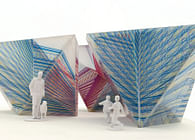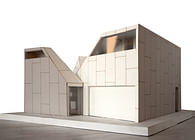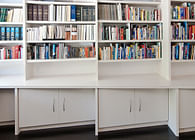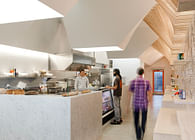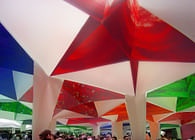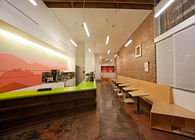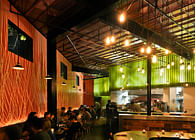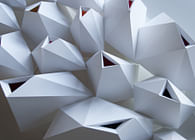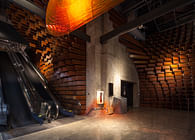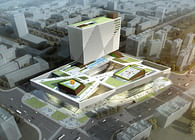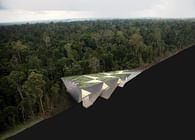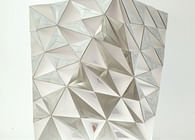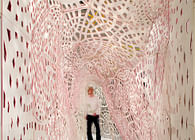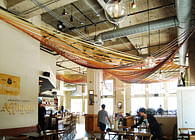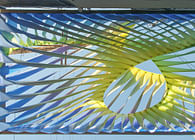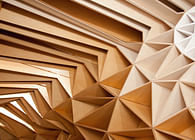
Los Angeles, CA | Brooklyn, NY
Openness: The Hungarian House of Music is designed to be a vibrant and welcoming institution that can be approached from every direction within the Park. The Mass of the building is opened up on all five sides of the site through a series of fissures, allowing multiple entries directly into the central lobby.
Integration: Formed by a series of overlapping arcs, the mass of the building is tied to several surrounding outdoor spaces defined by the same set of arcs. The outdoor stage, entry plaza and neighboring lawns align with and extend in toward the center of the building.
Orchestration: The building is an orchestration of sinuous surfaces and spaces. Moving along its overlapping arcs is intended to evoke the creation and reception of music: the orchestration of multiple overlapping flows, each a distinct evolving thread that is seamlessly aligned, overlaid and integrated with the other elements of the composition.
Tangency: This orchestration is marked by points of tangency - moments of suspension between two vectors or volumes, much like the alignment of rhythms or tones in an audio composition. These intersections are instances of choice, emblematic of creativity and composition.
Five Lobes: Organizationally, the building is made up of five distinct lobes, interwoven in the central atrium space. Each lobe is specifically suited to its given program, allowing for different floor levels, room sizes, acoustical separations, and distinct identities on both the interior and exterior. Roughly triangular, each lobe is day-lit on all sides and organized by a ‘grain’ of parallel arcs leading to and from the central lobby.
Façade: An extruded ceramic louvre system with a palette of 34 colors creates dynamic visual effects as visitors approach and move around the building while integrating large areas of glass into a consistent composition. At the outdoor stage, louvres have a triangular profile designed to disperse higher-frequency sound reflections, allowing the building to serve as the acoustical backdrop for the stage.
Outdoor stage: The outdoor stage is nestled into the mass of the building which serves as an acoustical shell. The building’s louvres have a triangular profile designed to disperse higher-frequency sound reflections. The outdoor stage is accessed from the building’s basement and connected via service elevator and stairs to the indoor stage back-of-house zone. The venue’s pinched elliptical shape allows for large performances with up to 1000 spectators or very intimate events with seating on the stage itself.
Interior
Central Lobby: Each of the five lobes is organized by a ‘grain’ of parallel arcs that converge at the central lobby, creating a dynamic array of structure and circulation at three different levels. Light filters down through this array from roughly triangular skylights surrounding this space and the colors of the surrounding walls bleeds into the more neutral lobby space. The primary stair leads from the main entrance up to education on the 6m level and further up to exhibition on the 9.5m level in a single counter-clockwise loop.
Exhibition: The central lobby, which can be entered from the East (Városligeti allée) and Northwest (Vajdahunyad Castle and the Ice Skating Rink), contains ticketing and coat check to the right of the main entry. The cafe adjacent to the lobby is set 50cm below lobby level. Ticketing thresholds are at the entrance to the individual lobes containing the temporary exhibition hall and the permanent exhibition sequence. Temporary exhibitions are contained in a large open hall on two levels connected by the main stair and a large art-handling elevator at the entrance. This elevator also connects to ample storage and loading dock at the basement level. The permanent exhibition area is a self-contained sequence over two levels incorporating the sound dome at the entrance to the second level at 9.5m.
Performance: The interior multi-purpose hall is accessed through the lobby and a dramatic double height intermission space overlooking the outdoor stage. The central lobby and adjacent cafe serve as overflow spaces before and after performances. Bathrooms are adjacent to intermission area and the back-of-house contains a dedicated stair and elevator to the basement, loading dock and outdoor stage. The balcony as well as VIP spaces are reached via a dedicated stair and elevator.
Education: The lecture hall is located at ground level as a second primary event space opposite the main multi-purpose hall and adjacent to the cafe. Above this at the 6m level and reached via the main stair or elevator are the library and multi-media space. The classrooms are on the same level, clustered around a dedicated central gathering space.
Administration: Office and administrative spaces are located on the ground level behind the ticketing area adjacent to the main entrance and on the 9.5m level across from the main elevator and adjacent to the upper exhibition spaces. Each level is day lit and features a set of offices around a central open office and meeting space.
Technical: We have adopted a holistic approach to sustainability, reducing loads through passive design, energy-efficient active systems, energy recovery, and, finally, on-site energy generation. We project achieving an Energy Use Intensity of 81 kWh/sm-year, which represents a nearly 50% reduction in energy com¬pared to a conventional approach and exceeds the specified ‘almost zero’ energy criteria.
Status: Competition Entry
Location: Budapest, HU






